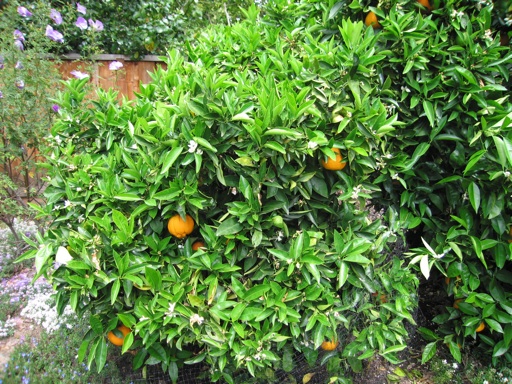Navel Orange Bush

We are lucky enough to live in a house that has an established navel orange bush (see picture). It was planted by one of the previous owners. This bush must be over 20 years old given the girth of its trunk.
Our navel orange bush produces the best tasting oranges I have ever eaten. The flesh of the oranges is soft and tender, unlike the tough fleshed oranges I typically buy in the supermarket. And the flavor is superb. They are juicy, with a nice sweet-tart orange flavor. Although I cannot be sure what type of navel it is, I believe it is a Washington navel given the high quality of the fruit. Washington (Bahia) navel is generally considered to be the best tasting orange.
Although navel oranges are known for ripening in the winter, our navel oranges are ripe now, in April and May. Our climate is probably too cool to stimulate winter ripening, but it appears to be warm enough to generate some very good fruit. Our summer highs average in the high 70s to low 80s, and our winter highs average in the 50s.
The first two years I lived in this house, the leaves of this bush would turn yellow each spring. Then, I learned that yellowing leaves is typically a sign of a lack of nitrogen. Oranges need lots of nitrogen, particularly in the spring when they are growing and blooming. For the past several years, I have been fertilizing our two oranges (navel and valencia) once a month from February through July with a general purpose fertilizer, 16-16-16. The first of these three numbers indicates the percentage of nitrogen in the fertilizer.
I give each bush 3-4 cups in each application, because both of them are quite mature at this point. The result has been more blooms, more oranges, and beautiful dark green leaves throughout the spring and summer months.
Some of our neighbors have large orange trees. They never seem to fertilize them and yet they always look beautiful! I am not sure how they get away with neglecting these trees. Although, our bushes often have more oranges even though they are smaller. 😉
May 03 2009 12:14 pm | Oranges